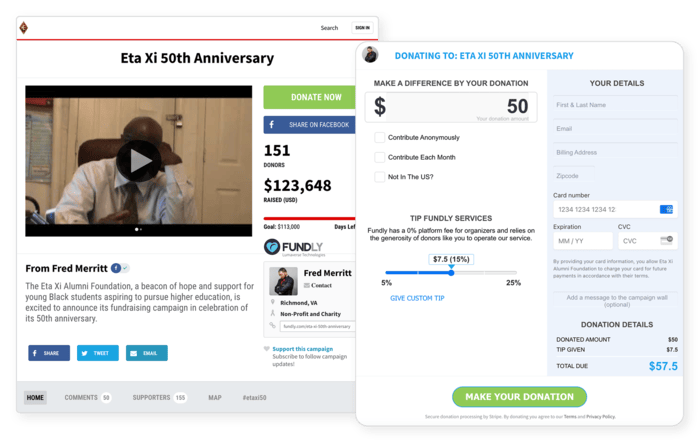Retaining Support: Types of Content Your Donors Want to See
Your donors give their hard-earned money because they believe in your organization’s work. To maintain their trust and ongoing support, you need to keep them engaged and informed on the impact of their contributions.
A strong communication strategy helps accomplish exactly that! Donors want to feel valued, involved, and appreciated, and the information you share with them is instrumental in fostering that connection.
To help you take charge of your marketing strategy, we’ll explore five types of content donors will appreciate seeing from your nonprofit. Each one plays a unique role in building trust, strengthening engagement, and growing your support base.
1. Impact stories
Sharing impact stories is one of the most powerful ways to engage donors and demonstrate the tangible results of their support. By telling real-life stories of change, you show them exactly where their money is going, which fosters deeper emotional connections to your cause.
When donors see those impacted by their contributions, their support feels more meaningful. Here are a few ways to bring your narratives to life:
Include direct quotes. Share testimonials from individuals or communities directly affected by donations. Personal perspectives add authenticity.- Deliver stories in engaging formats. For example, you might record an interview with a team member who helped rescue a litter of puppies at your animal shelter. They can explain how donations helped fund rescue operations, medical treatments, and food. Then, you could piece together clips of your team caring for the pups to go with the interview.
- Show the journey. Don’t just focus on the end result. Show the process behind the change—such as the efforts that went into rescuing animals, providing medical care, or building community programs. This adds depth to your story and demonstrates the hard work behind the scenes.
- Share both successes and challenges. Be transparent about any hurdles you’ve encountered. Donors appreciate hearing how their support has helped overcome obstacles, whether it's keeping an essential program afloat or providing aid during an emergency.
Impact stories are not only effective for building engagement but also for driving donations. Include them in your fundraising appeals and campaigns. For example, embed a powerful video on your
crowdfunding page to communicate your case for support, which might look like this:

2. Frequent updates
Around 41% of donors would give again if they received personalized communications on their impact. In other words, providing regular updates is essential for retaining donor interest.
Share regular updates through these methods:
Newsletters: Create a newsletter that you send semi-frequently, such as once a month. Include updates on projects, recent campaigns, mission-related news, and upcoming initiatives.- Social Media Updates: Post bite-sized updates on social media to share quick wins, milestones, or timely news. Use features like Stories or Reels to give behind-the-scenes looks and celebrate progress.
- Impact Reports: Share detailed reports illustrating the tangible results that donors have helped create. Strong impact reporting highlights key achievements, financial transparency, and the outcomes of funded programs.
- Exclusive Donor-Only Content: Send special content that only donors can access, such as sneak peeks at new projects, exclusive interviews, and in-depth stories of donations at work.
- Blog Posts: Write regular blog posts on your nonprofit’s website that dive into specific projects, share stories about beneficiaries, or discuss key issues your organization is tackling.
Fundly recommends providing updates on fundraising campaign progress, too. For instance, you might post milestones, such as reaching your halfway mark, to social media to give donors a chance to celebrate and make a push to the finish line.
You can also segment emails and texts to provide tailored updates. For example, you might send a series of project updates to someone who gave in support of that particular initiative.
3. Supporter spotlights
Once you’ve communicated impact, consider turning the spotlight on the people who help make that work possible: your supporters. While most donors aren’t seeking recognition when they give, telling their stories and highlighting their generosity can deepen their connections to your cause and inspire others.
Show potential donors how real people like them are making a difference. This type of content serves as valuable
social proof and can take many forms, such as:
One-on-one interviews with mid-size or major donors- “Donor of the Month” features in your email newsletter or on social media
- Milestone celebrations, like years of giving or total impact
- Quick video clips or Reels with supporters sharing why they give
- Pull-quote graphics from testimonials on your website
You don’t have to stick strictly to donor spotlights, either. Recognizing volunteers, peer fundraisers, board members, or grassroots advocates shows the broader ecosystem of support behind your mission. This may even inspire donors to get involved in other ways, helping them feel like more instrumental partners in your success.
For example, you might highlight how a volunteer helped your food bank reach record holiday numbers or how an advocate organized a local event,
raised funds, and contacted policymakers to support a legislative win.
4. Surveys and polls
Surveys and polls give you a snapshot of donor engagement and opportunities for improvement. They help you understand donors’ preferences and expectations so that you can adjust your strategies for better results.
This type of content shines due to its versatility. You might create a poll asking for input on a project or recommendations for new involvement opportunities.
Regardless of why you’re requesting feedback, you’ll communicate that you value donors’ opinions and want to improve their experiences with your organization.
Short, interactive surveys could be as simple as gathering ideas for projects donors would like you to focus on in the coming year. Let’s say you’re creating a new donor survey. You might ask a mix of multiple-choice and open-ended questions like:
What motivated you to donate to our cause?- How would you prefer to receive updates about your donation’s impact?
- Would you be interested in participating in upcoming events or volunteer opportunities?
- Are there specific programs or areas of our work that interest you most?
Think of each survey or poll as an opportunity to get to know your donors. You don’t need to create a full-fledged survey, either. Social media provides easy polling tools for quick surveys that garner engagement.
For example, let’s say your nature center recently rescued a turtle tangled in a fishing line. While you rehabilitate him, you might post a picture of him to your Instagram Story, asking followers to vote on a new name: Shelldon, Turbo, Rocky, or Franklin. This is a quick way to involve donors in your mission.
After gathering feedback, don’t just leave it there;
use it. These valuable insights will improve communications, align
financial management practices with expectations, and help donors feel emotionally involved in your work, even if they’re just naming a turtle!
5. Personalized thank-you messages
Donor appreciation is a cornerstone of any solid retention strategy. Whether it’s a handwritten note or a personalized email, taking the time to say thank you goes a long way. This type of content reinforces the donor’s impact and helps them feel like a valued member of your supporter community.
eCardWidget’s donor thank-you email guide outlines these key elements to include:
A compelling subject line, potentially including the recipient’s name (e.g., “Andrew, your donation fed a family of three this week”)- A reference to their gift amount, making it clear that you value their specific contribution
- An impact statement, such as “Your $25 went toward purchasing groceries for a single mother and her two children, ensuring they had warm meals this week.”
- Powerful visuals that communicate an impact story or share a behind-the-scenes look at a project
- A call to action to grow their relationship, such as by signing up for your newsletter or following your social media accounts
- A signature from a representative of your organization, such as the executive director or a fundraising coordinator
Send appreciation messages within 48 hours of receiving the donation, while the gift—and the feeling of generosity—is still fresh in the donor’s mind. Timely, thoughtful thank-you notes don’t just check a box; they lay the groundwork for long-term support.
Creating meaningful content is about deepening relationships, showing impact, and making donors feel part of something bigger. As you test out these different types of content in fundraising appeals and follow-ups, pay attention to which ones garner the most engagement. Keep listening to your donors and communicating with authenticity. That’s how you turn a one-time gift into lasting support.
About the Author
Scoti Hahn
Product Manager for Fundly
Jennifer C. Loftus is a Founding Partner of and National Director for Astron Solutions, a compensation consulting firm. Jennifer has 23 years of experience garnered at organizations including the Hay Group, Parsons Brinckerhoff, Eagle Electric Manufacturing Company, and Harcourt General.
Jennifer has held volunteer leadership roles with SHRM, New York City SHRM, and WorldatWork. She serves as a subject matter expert to the SHRM Learning System and as a SHRM instructor. Jennifer is a sought-after speaker for local & national conferences and media outlets.
Jennifer has an MBA in Human Resource Management with highest honors from Pace University and a BS in Accounting summa cum laude from Rutgers University.
Jennifer holds Adjunct Professor roles with Pace University, Long Island University, and LIM College.
Jennifer received the 2014 Gotham Comedy Foundation’s Lifetime Ambassador of Laughter Award.








































































































